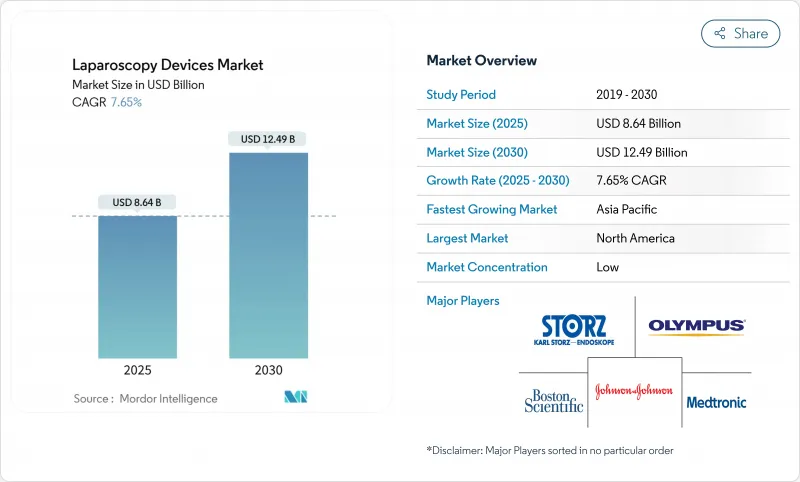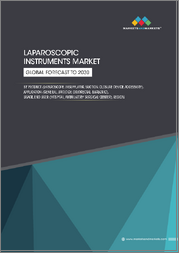
|
시장보고서
상품코드
1842526
복강경 기기 시장 : 시장 점유율 분석, 산업 동향, 통계, 성장 예측(2025-2030년)Laparoscopy Devices - Market Share Analysis, Industry Trends & Statistics, Growth Forecasts (2025 - 2030) |
||||||
복강경 기기 시장은 2025년에 86억 4,000만 달러로 추정되고, 2030년에는 124억 9,000만 달러에 이를 전망이며, CAGR 7.65%로 발전할 것으로 예측됩니다.

이 기세를 뒷받침하는 것은 저침습 수술에 대한 선호도 증가, AI 기반 수술 시스템에 대한 꾸준한 규제 지원, 외래수술센터(ASC)의 보급입니다. 지속적인 수요는 4K와 3D 이미지의 융합, 민첩성을 향상시키는 로봇 플랫폼, 비만 관련 대사 수술의 성장으로 이어집니다. 제조업체는 무균 기준을 유지하면서 지속가능성에 대한 우려를 해결하는 재사용 가능한 도구 혁신으로 대응합니다. 동시에 지역 공급망의 다양화는 물류 위험을 줄이고 주요 구성 요소의 납기를 단축합니다.
세계의 복강경 기기 시장 동향 및 인사이트
저침습 수술에 대한 수요 증가
평균 재원 일수가 2-3일 단축되고 수술 후 회복이 빨라지기 때문에 선택 수술과 급성기 수술에서는 복강경 기술이 점점 선호되고 있습니다. 병원은 재입원률 감소로 혜택을 받으며 환자는 수술 후 통증이 적고 직장 복귀가 빠르다고 보고합니다. 저침습 수술의 휄로우십 등록자 수가 증가하고 숙련된 전문가의 안정적인 파이프라인이 확보되었습니다. 환자의 선호, 지불자의 지지, 외과의의 능력이라는 선순환이 복강경 기기 시장을 계속 견인하고 있습니다.
4K, 3D, AR 및 AI 비전을 포함한 기술적 도약
새로운 이미지 처리 스택은 해상도를 4배로 늘리고 복잡한 해부에서 오류율을 줄이는 깊이 지각을 추가합니다. 다빈치 5와 같은 AI 기반 시스템은 기구의 궤도를 예측하는 예측 분석을 제공하여 외과의사가 더 빠르고 중요한 구조를 확인할 수 있도록 지원합니다. 증강현실 오버레이는 수술 전 스캔과 실제 해부학적 구조를 일치시켜 수술 시간을 단축하며 수술실 회전율을 향상시킵니다.
높은 설비 투자 및 유지 보수 비용
완전 장비의 로봇 수술실은 200만-300만 달러, 지속적인 서비스료는 연간 20만 달러를 넘기 때문에 중견 병원에서는 구입이 지연되고 있습니다. 공급망의 혼란으로 인해 물류 비용이 상승하고 공급자는 총 소유 비용을 조사하게 되었습니다. 이러한 장벽에 대항하기 위해, 사용량에 따른 지불에 의한 자금 조달이나 공유 소유 모델이 등장하고 있습니다.
부문 분석
2024년 복강경 기기 시장에서 에너지 장비는 27.41%로 가장 큰 점유율을 차지했습니다. 로봇 지원 시스템은 절대량이 적은 반면, 2030년까지 CAGR 8.61%로 성장이 예측되고 있습니다. 이 확대로 로봇 정장의 복강경 기기 시장 규모는 10년 후까지 2자리수 억 달러에 달할 것으로 보입니다. 차세대 복강경은 4K/3D 광학계, 자동 화이트 밸런스, 안정된 기복막을 유지하는 누설 없는 트로커 씰을 통합하고 있습니다. 핸드 기구는 촉각 피드백 모터를 채용해, 장시간의 비만 사례에 있어서의 외과의의 피로를 경감합니다. 일회용 트로커는 환경 목표에 대응하기 위해 식물 유래 또는 재활용 가능한 소재로 계속 이동하고 있습니다. 제조업체는 또한 장비의 마모를 예측하는 서비스 분석을 번들로 하여 예정되지 않은 다운타임을 제한합니다.
일회용 기구에 대한 축발은 흡입 관류 기구와 스테이플러 라인 전체에 빠르게 퍼져 있습니다. 스마트 에너지 장비는 현재 열 확산을 완화하는 조직 접촉 센서를 갖추고 좁은 공간에서의 안전성을 향상시키고 있습니다. 따라서 프리미엄 액세서리 라인은 자본 시설에 대한 가격 압력을 완화하는 경상 수익을 제공합니다.
2024년 복강경 기기 시장은 담낭 적출술과 역류 방지술이 많기 때문에 일반 수술이 29.87%의 점유율을 차지하고 있습니다. 그러나 부인과에서는 로봇 자궁 적출술의 채용이 확대되고 CAGR은 8.29%로 가장 높습니다. 이 궤적은 부인과의 복강경 기기 시장 점유율이 2030년까지 현저하게 상승할 것으로 보입니다.
대장 항문 수술과 비뇨기 수술에서 AI 대응 카메라는 임상의의 중요한 뷰 벤치마크 달성을 일관되게 지원하여 수술 중 손상을 줄입니다. 비만이 증가함에 따라 비만 수술의 수는 꾸준히 증가하고 로봇 플랫폼은 입원 기간을 더욱 단축합니다. 흉부 수술과 소아 수술 분야는 여전히 소규모이지만 도구의 소형화로 인해 기세가 커지고 있습니다.
지역 분석
북미는 2024년 세계 매출의 40.39%를 차지했는데, 밀집된 설치 기반과 유리한 상환에 의해 지원되고 있습니다. 미국 시설에서는 다빈치 5 출시 후 로봇에 의한 일반 수술의 사례 수가 2자리 증가를 기록했습니다. 캐나다 병원은 주 조성금 제도를 통해 실적을 재현하고 멕시코는 국경을 넘은 의료 관광객을 수용하기 위해 민간 부문의 도입을 늘리고 있습니다.
아시아태평양의 CAGR은 가장 빠른 8.56%로 성장이 예측됩니다. 중국 병원은 대규모 증설을 계속하고 최근 국내 승인을 받아 비용 최적화된 로봇 플랫폼의 현지 생산을 가속화합니다. 일본과 한국은 화상처리 전문지식을 활용하여 고해상도 카메라 스택을 수출합니다. 인도의 Tier1 도시에서는 왕성한 수요가 보이지만 농촌 지역의 도입은 자본 제약으로 인해 느립니다. 태국과 말레이시아의 의료 관광 회랑이 증례 수를 더욱 밀어 올립니다.
유럽의 성장은 국민 건강 보험과 외과 의사 양성 네트워크에 의해 지원되고 안정적입니다. 그러나 예산의 상한이 있기 때문에 북유럽 이외의 로봇 도입은 지연될 수 있습니다. 지역 내 이니셔티브는 탈탄소화 목표를 충족시키기 위해 재사용 가능한 장비 조달을 촉진합니다. 중동 및 아프리카에서는 걸프 협력 회의 국가가 주요 의료 도시에 투자하고 있으며, 도입이 진행되고 있는 반면, 사하라 이남의 아프리카에서는 기증자 자금에 의한 MIS 프로그램에 크게 의존하고 있습니다. 남미에서는 브라질의 민간 보험 회사와 아르헨티나의 공공 부문의 현대화를 중심으로 완만한 성장을 볼 수 있습니다.
기타 혜택 :
- 엑셀 형식 시장 예측(ME) 시트
- 3개월간의 애널리스트 서포트
목차
제1장 서론
- 조사의 전제조건 및 시장 정의
- 조사 범위
제2장 조사 방법
제3장 주요 요약
제4장 시장 상황
- 시장 개요
- 시장 성장 촉진요인
- 저침습 수술에 대한 수요 증가
- 4K, 3D, AR 및 AI 비전 등의 기술적 도약
- 비만 및 대사성 질환의 유병률 증가
- 고소득 국가에서의 외래수술센터(ASC)의 급증
- 복강경 기기의 일회용화
- AI를 활용한 수술중 해석과 종량 과금 모델
- 시장 성장 억제요인
- 고액의 설비 투자 및 유지 보수 비용
- 고도의 기술을 가진 복강경 외과의의 부족
- 일회용 플라스틱에 대한 지속가능성에 반발
- 내강 치료에 의한 복강경 수술의 카니바리제이션
- 밸류체인 및 공급망 분석
- 규제 상황
- 기술적 전망
- Porter's Five Forces 분석
- 신규 참가업체의 위협
- 구매자의 협상력
- 공급기업의 협상력
- 대체품의 위협
- 경쟁 기업간 경쟁 관계
제5장 시장 규모 및 성장 예측
- 제품별
- 에너지 기기
- 전기 수술용 및 바이폴라 발생기
- 초음파 및 RF 에너지 시스템
- 복강경
- 비디오 복강경(HD/4K/3D)
- 광섬유 복강경
- 흡입 및 액세스 장치
- CO2 흡입기
- 트로커 및 캐뉼러
- 핸드헬드 기구
- 그래퍼 및 디스셉터
- 가위 및 전도
- 흡입 및 관류 장치
- 로봇 지원 복강경 시스템
- 액세서리 및 소모품
- 에너지 기기
- 용도별
- 일반 외과
- 비만 수술
- 부인과 수술
- 비뇨기 수술
- 대장 항문 외과
- 기타 용도
- 연령층별
- 성인
- 소아
- 고령
- 최종 사용자별
- 병원
- 외래수술센터(ASC)
- 기타
- 지역별
- 북미
- 미국
- 캐나다
- 멕시코
- 유럽
- 독일
- 영국
- 프랑스
- 이탈리아
- 스페인
- 기타 유럽
- 아시아태평양
- 중국
- 일본
- 인도
- 한국
- 호주
- 기타 아시아태평양
- 중동 및 아프리카
- GCC
- 남아프리카
- 기타 중동 및 아프리카
- 남미
- 브라질
- 아르헨티나
- 기타 남미
- 북미
제6장 경쟁 구도
- 시장 집중도
- 시장 점유율 분석
- 기업 프로파일
- Olympus Corporation
- Medtronic plc
- Johnson & Johnson(Ethicon)
- Karl Storz SE & Co. KG
- Stryker Corporation
- Boston Scientific Corporation
- B. Braun SE
- CONMED Corporation
- Richard Wolf GmbH
- Smith & Nephew plc
- Intuitive Surgical Inc.
- Teleflex Incorporated
- Applied Medical Resources
- Erbe Elektromedizin GmbH
- Genicon Inc.
- Microline Surgical
- Ackermann Instrumente GmbH
- Genesis MedTech
- Endoso Life
- Akino Medical
제7장 시장 기회 및 전망
AJY 25.10.29The laparoscopic devices market is valued at USD 8.64 billion in 2025 and is forecast to reach USD 12.49 billion by 2030, advancing at a 7.65% CAGR.

Momentum is underpinned by the rising preference for minimally invasive procedures, steady regulatory support for AI-enabled surgical systems, and wider availability of ambulatory surgical centers. Sustained demand also comes from the convergence of 4K and 3D imaging, robotic platforms that improve dexterity, and growth in obesity-related metabolic surgeries. Manufacturers are responding with reusable tool innovations that address sustainability concerns while maintaining sterility standards. Simultaneously, regional supply-chain diversification mitigates logistics risks and tightens delivery timelines for key components.
Global Laparoscopy Devices Market Trends and Insights
Rising Demand for Minimally-Invasive Procedures
Elective and acute surgeries increasingly favor laparoscopic techniques because average hospital stays fall by 2-3 days, and postsurgical recovery accelerates. Hospitals benefit from lower readmission rates, while patients report less postoperative pain and faster return to work. Fellowship enrollments in minimally invasive surgery have risen, ensuring a steady pipeline of skilled practitioners. The virtuous cycle of patient preference, payer support, and surgeon competency continues to lift the laparoscopic devices market.
Technological Leaps Including 4K/3D/AR and AI Vision
New imaging stacks quadruple resolution and add depth perception that reduces error rates in intricate dissections. AI-enabled systems such as the da Vinci 5 supply predictive analytics that anticipate instrument trajectory, helping surgeons identify critical structures sooner. Augmented reality overlays align preoperative scans with live anatomy and shorten operative times, improving operating-room turnover.
High Capital & Maintenance Outlay
Fully-featured robotic suites can cost USD 2-3 million with ongoing service fees topping USD 200,000 annually, delaying purchases by mid-tier hospitals. Supply chain turbulence has lifted logistics costs, causing providers to scrutinize total cost of ownership. Pay-per-use financing and shared-ownership models have emerged to counterbalance these barriers.
Other drivers and restraints analyzed in the detailed report include:
- Growing Prevalence of Obesity & Metabolic Disease
- Rapid Ambulatory Surgical Centers Build-Out in High-Income Economies
- Shortage of Advanced-Skill Laparoscopic Surgeons
For complete list of drivers and restraints, kindly check the Table Of Contents.
Segment Analysis
Energy instruments held the largest slice of the laparoscopic devices market at 27.41% in 2024 because almost every procedure requires electrosurgery or tissue sealing. Robotic-assisted systems, while smaller in absolute volume, are forecast to post an 8.61% CAGR through 2030. That expansion will lift the laparoscopic devices market size for robotic suites to USD-denominated double-digit billions by decade-end. Next-generation laparoscopes integrate 4K/3D optics, automated white-balance, and leak-proof trocar seals that maintain stable pneumoperitoneum. Hand instruments adopt haptic feedback motors that lessen surgeon fatigue during lengthy bariatric cases. Disposable trocars continue shifting toward plant-based or recyclable materials to address environmental targets. Manufacturers also bundle service analytics that predict instrument wear, limiting unplanned downtime.
The pivot to single-use instruments spreads quickly across suction-irrigation and stapler lines because hospitals calculate that reprocessing costs can surpass USD 200 per item. Smart energy devices now feature tissue-contact sensors that moderate thermal spread, improving safety in confined spaces. Premium accessory lines thus supply recurring revenue that softens pricing pressure on capital equipment.
General surgery contributed the largest 29.87% slice of the laparoscopic devices market in 2024, owing to high volumes of cholecystectomy and anti-reflux procedures. Gynecology, however, shows the highest 8.29% CAGR as robotic hysterectomy adoption widens. That trajectory will lift gynecology's laparoscopic devices market share notably by 2030.
In colorectal and urological surgery, AI-enabled cameras help clinicians consistently achieve critical-view benchmarks, slashing intraoperative injuries. Bariatric volumes rise steadily with obesity growth, while robotic platforms further shorten hospital stays. Thoracic and pediatric segments remain smaller yet gain momentum from tool miniaturization.
The Laparoscopy Devices Market is Segmented by Product (Energy Devices, Laparoscopes, and More), Application (General Surgery, Bariatric Surgery, and More), Age Group (Adults, Pediatric, and More), End User (Hospitals, Ambulatory Surgical Centers (ASCs) and More), and Geography (North America, Europe, Asia-Pacific, Middle East and Africa, and South America). The Market and Forecasts are Provided in Terms of Value (USD).
Geography Analysis
North America controlled 40.39% of global revenue in 2024, anchored by dense installed bases and favorable reimbursement. United States facilities logged double-digit growth in robotic general surgery cases after the da Vinci 5 launch. Canadian hospitals replicate performance through provincial funding schemes, while Mexico increases private-sector adoption to serve cross-border medical tourists.
Asia-Pacific is forecast to post the fastest 8.56% CAGR. Chinese hospitals continue large-scale build-outs and accelerate local production of cost-optimized robotic platforms following recent domestic approvals. Japan and South Korea leverage their imaging expertise to export high-resolution camera stacks. India's tier-one cities witness robust demand, though rural uptake remains slower due to capital limitations. Medical-tourism corridors in Thailand and Malaysia further boost case volumes.
European growth is stable, supported by national health insurance and surgeon training networks. Budget caps, however, can delay broad robotic acquisition outside Northern Europe. Intra-region initiatives promote reusable instrument procurement to align with decarbonization goals. The Middle East and Africa observe rising adoption in Gulf Cooperation Council states investing in flagship medical cities, whereas sub-Saharan Africa relies heavily on donor-funded MIS programs . South America sees moderate gains centered on Brazil's private insurers and Argentina's public-sector modernization.
- Olympus
- Medtronic
- Johnson & Johnson
- Karl Storz
- Stryker
- Boston Scientific
- B. Braun
- Conmed
- Richard Wolf
- Smiths Group
- Intuitive Surgical
- Teleflex
- Applied Medical Resources
- Erbe Elektromedizin
- Genicon
- Microline Surgical
- Ackermann Instrumente
- Genesis MedTech
- Endoso Life
- Akino Medical
Additional Benefits:
- The market estimate (ME) sheet in Excel format
- 3 months of analyst support
TABLE OF CONTENTS
1 Introduction
- 1.1 Study Assumptions & Market Definition
- 1.2 Scope of the Study
2 Research Methodology
3 Executive Summary
4 Market Landscape
- 4.1 Market Overview
- 4.2 Market Drivers
- 4.2.1 Rising demand for minimally-invasive procedures
- 4.2.2 Technological leaps including 4K/3D/AR and AI vision
- 4.2.3 Growing prevalence of obesity & metabolic disease
- 4.2.4 Rapid Ambulatory Surgical Centers build-out in high-income economies
- 4.2.5 Shift to single-use laparoscopic instruments
- 4.2.6 AI-enabled intra-operative analytics & pay-per-use models
- 4.3 Market Restraints
- 4.3.1 High capital & maintenance outlay
- 4.3.2 Shortage of advanced-skill laparoscopic surgeons
- 4.3.3 Sustainability backlash on disposable plastics
- 4.3.4 Endoluminal therapies cannibalising laparoscopic surgery volumes
- 4.4 Value / Supply-Chain Analysis
- 4.5 Regulatory Landscape
- 4.6 Technological Outlook
- 4.7 Porter's Five Forces Analysis
- 4.7.1 Threat of New Entrants
- 4.7.2 Bargaining Power of Buyers
- 4.7.3 Bargaining Power of Suppliers
- 4.7.4 Threat of Substitutes
- 4.7.5 Competitive Rivalry
5 Market Size & Growth Forecasts (Value, USD)
- 5.1 By Product
- 5.1.1 Energy Devices
- 5.1.1.1 Electrosurgical / Bipolar Generators
- 5.1.1.2 Ultrasonic & RF Energy Systems
- 5.1.2 Laparoscopes
- 5.1.2.1 Video Laparoscopes (HD/4K/3D)
- 5.1.2.2 Fibre-optic Laparoscopes
- 5.1.3 Insufflation & Access Devices
- 5.1.3.1 CO2 Insufflators
- 5.1.3.2 Trocars & Cannulas
- 5.1.4 Handheld Instruments
- 5.1.4.1 Graspers & Dissectors
- 5.1.4.2 Scissors & Shears
- 5.1.5 Suction / Irrigation Devices
- 5.1.6 Robotic-Assisted Laparoscopy Systems
- 5.1.7 Accessories & Consumables
- 5.1.1 Energy Devices
- 5.2 By Application
- 5.2.1 General Surgery
- 5.2.2 Bariatric Surgery
- 5.2.3 Gynecological Surgery
- 5.2.4 Urological Surgery
- 5.2.5 Colorectal Surgery
- 5.2.6 Other Applications
- 5.3 By Age Group
- 5.3.1 Adults
- 5.3.2 Pediatric
- 5.3.3 Geriatric
- 5.4 By End User
- 5.4.1 Hospitals
- 5.4.2 Ambulatory Surgical Centers (ASCs)
- 5.4.3 Others
- 5.5 By Geography
- 5.5.1 North America
- 5.5.1.1 United States
- 5.5.1.2 Canada
- 5.5.1.3 Mexico
- 5.5.2 Europe
- 5.5.2.1 Germany
- 5.5.2.2 United Kingdom
- 5.5.2.3 France
- 5.5.2.4 Italy
- 5.5.2.5 Spain
- 5.5.2.6 Rest of Europe
- 5.5.3 Asia-Pacific
- 5.5.3.1 China
- 5.5.3.2 Japan
- 5.5.3.3 India
- 5.5.3.4 South Korea
- 5.5.3.5 Australia
- 5.5.3.6 Rest of Asia-Pacific
- 5.5.4 Middle East and Africa
- 5.5.4.1 GCC
- 5.5.4.2 South Africa
- 5.5.4.3 Rest of Middle East and Africa
- 5.5.5 South America
- 5.5.5.1 Brazil
- 5.5.5.2 Argentina
- 5.5.5.3 Rest of South America
- 5.5.1 North America
6 Competitive Landscape
- 6.1 Market Concentration
- 6.2 Market Share Analysis
- 6.3 Company Profiles (includes Global level Overview, Market level overview, Core Segments, Financials as available, Strategic Information, Market Rank/Share, Products & Services, Recent Developments)
- 6.3.1 Olympus Corporation
- 6.3.2 Medtronic plc
- 6.3.3 Johnson & Johnson (Ethicon)
- 6.3.4 Karl Storz SE & Co. KG
- 6.3.5 Stryker Corporation
- 6.3.6 Boston Scientific Corporation
- 6.3.7 B. Braun SE
- 6.3.8 CONMED Corporation
- 6.3.9 Richard Wolf GmbH
- 6.3.10 Smith & Nephew plc
- 6.3.11 Intuitive Surgical Inc.
- 6.3.12 Teleflex Incorporated
- 6.3.13 Applied Medical Resources
- 6.3.14 Erbe Elektromedizin GmbH
- 6.3.15 Genicon Inc.
- 6.3.16 Microline Surgical
- 6.3.17 Ackermann Instrumente GmbH
- 6.3.18 Genesis MedTech
- 6.3.19 Endoso Life
- 6.3.20 Akino Medical
7 Market Opportunities & Future Outlook
- 7.1 White-space & Unmet-need Assessment

















